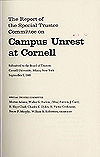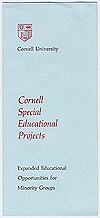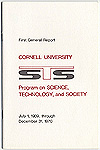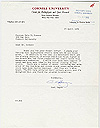Symbols of the University | The Cornell Public Library | Cornell’s Twelve Presidents | | Andrew Dickson White, President, 1866-1885 | | Charles Kendall Adams, President, 1885-1892 | | Jacob Gould Schurman, President, 1892-1920 | | Livingston Farrand, President, 1921-1937 | | Edmund Ezra Day, President, 1937-1949 | | Deane Waldo Malott, President, 1951-1963 | | James Alfred Perkins, President, 1963-1969 | | Dale Raymond Corson, President, 1969-1977 | | Frank Howard Trevor Rhodes, President, 1977-1995 | | Hunter Ripley Rawlings III, President, 1995-2003 | | Jeffrey Sean Lehman, 2003-2005 | | David J. Skorton, 2006 | Inaugurating the Presidents |
| Cornell’s Twelve Presidents Dale Raymond Corson, President, 1969-1977 Dale R. Corson became president in 1969, leading the university through the final years of the Vietnam War and student activism, and through the economic recession of the 1970s. His presidency returned the university to stability, to concentration on research, teaching, and scholarship. Corson brought together the state and endowed components of Cornell, forming one university that enjoyed public and private support, as envisioned by White and Cornell and articulated by Schurman. Significant support was provided for the research program at Arecibo, the Wilson Synchrotron Laboratory, and the Nanofabrication Facility. He revitalized the Department of Geology, expanded the Division of Biological Sciences, and added new programs such as Medieval Studies. The Johnson Art Museum was completed. He encouraged such multi-disciplinary programs as Science, Technology, and Society, the Materials Science Center, environmental programs, radio physics, and space research.
The status of women on campus was greatly improved during the Corson presidency. A Womenís Studies Program was formally established in 1972. A Provostís Advisory Committee on the Status of Women was created and presented specific recommendations. The universityís policy statement on equal opportunity was changed to include sex among the proscribed criteria for admission to the university. New employment procedures were implemented, and increasing numbers of women were appointed to the faculty and to high administrative positions. He provided support for the Africana Studies and Research Center, which had come out of the black studies movement. President Corson recommended the formation of an Affirmative Action Advisory Board to monitor the status of women and minorities and to propose more effective procedures.
Dale R. Corson was born in Pittsburg, Kansas in 1914. He received in B.A. degree from the College of Emporia in 1934, his M.A. from the University of Kansas in 1935, and his Ph.D. in physics from the University of California at Berkeley in 1938. He was a staff member of Massachusetts Institute of Technology Radiation Laboratory from 1941 to 1943, and later served as a technical advisor at Air Force Headquarters in Washington, D.C. At the end of the war, he joined the staff of the Los Alamos Scientific Laboratory. In 1946 he came to Cornell University as an assistant professor of physics and helped design the Cornell Synchrotron. He was appointed associate professor of physics in 1947, became a full professor in 1956, was named chairman of the Physics Department in 1956, and became Dean of the College of Engineering in 1959. Dale Corson served as Provost of the University from 1963 to 1969, becoming Cornellís eighth president in 1969, a position he held until 1977. << Prev | Next >> |  + +
Dale Raymond Corson
President Corson at his desk, 1973. In the foreground sits the pen used by Secretary of State William P. Rogers to sign the Viet-Nam Peace Agreements, Paris, January 27, 1973. 
 + +
Anti-war Protest, 1969
Dale Corson addressing protestors on the Arts Quad in front of Olin Library, 1969. 
 + +

 + +
Africana Studies and Research Center
The Africana Studies and Research Center opened in 1969, following student protests. 
 + +

 + +
The Program on Science, Technology & Society
Cornell developed a Program on Science, Technology & Society, one of the first programs worldwide to apply policy analysis and related disciplines to science and technology. 
 + +
Carl Sagan

 + +
Asian Studies Program
The Asian Studies Program was one of several new programs added to Cornell's growing list of course offerings. 
 + +
Herbert F. Johnson Museum of Art
The Herbert F. Johnson Museum of Art, designed by I. M. Pei, was completed in 1973. 
|
